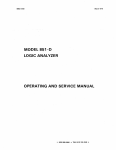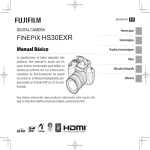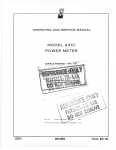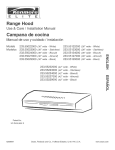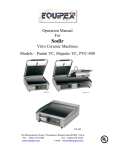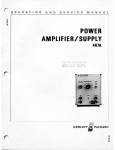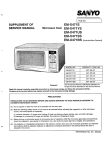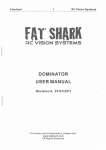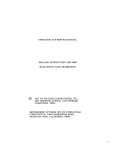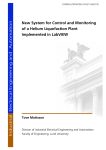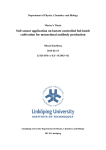Download HP 431B power meter - University of California, Berkeley
Transcript
• OPERATING AND SERVICE MANUAL MODEL 4318 POWER METER • SERIALS PREFIXED: 301-. 233-. & 221- Copyright H~WLETt.PACKARD COMPANY 1962 1501 PAGE MILL ROAD, PALO ALTO, CAlifORNIA, U.S,A. • 01370·2 Printed: MAR 1964 .section r Figure 1-1 ModeJ 431.l3 f Figure 1-1. MOdel 48113 Power Meter f 01370_1 Section I Paragraphs 1-1 to 1-4 Model 431B SECTION I GENERAL INFORMATION electrically isolated. One thermistor is used to absorb rf power; the other is used. to provide temperature compensation. Thus, the thermal drift problems normaUy associated with the thermistor-power meter arrangement have been greatly reduced. A single setting of the ZERO control on the most sensitive power range is maintained within 1% for all higher 1-1. DESCRIPTION. 1-2. The!f;j; Model 431BPower Meter, with!f;j;temperature compensated thermistor mounts, measures rf power from 10 micl'owatts (-20 dbm) to 10 milliwatts (+10 dbm) in the 10-mc to 40-gc frequency range. Direct reading accuracy of the instrument is ±3% of full scale. Instrument specifications are given in table 1-1. power ranges. 1-3. The design of the Model 431B and its thermistor mount, results in almost complete freedom from 1-4. The temperature compensated thermistor mounts used with the instrument are specifically designed for !f;j; Model 431A/B Power Meters. Coaxial and waveguide thermistor mounts cover the 10-mc to 40-gc frequency range. Table 1-2 gives thermistor mount operating frequency, mount configuration, and operating resistance. measurement- error caused by ambient temperature changes. The instrument incorporates two selfbalancing bridges with one arm of each bridge being a thermistor. The two matched thermistors, both located within the mount, are thermally coupled, but Table 1-1. Specifications Weight: Net 8 Ib (3.63 kg) with cover and cables 11-1/2 Ib (5.44 kg) Including battery; shippingapprox.13lb (5.9 kg) Instrument Type: Automatic, self-balancing for temperature compensated mounts Power Ranges: 7 ranges with full scale readings of 10, 30, 100 and 300 Ii w; 1, 3 and 10 mw. Also calibrated In dbm from -20 to +10. Accessories FUrnished: 5 ft (1.5 m) cablefor!f;j;temperature-compensated thermistor mounts. 7-1/2 ft(2.3 m) power cable, NEMAplug. Exiernal Bolometer: Temperature-compensated thermistor mounts required for operation (!f;j; 478A and 486A series). Accessories Available: 431A-95B Rechargeable Battery Pack for field Installation. Accuracy: ±3% of full scale from +20'C to+35'C, ±5% of full scale from O'C to +55'C !f;j; Models 478A and 486A Thermistor Mounts !f;j; Model 8402A Power Meter Calibrator !f;j; Model HOl-8401A Leveler Amplifier Zero Carry-Over: Less than 1% of fuU scale when zeroed on most se~sitlve range , Recorder/Voltmeter Output: Phone jack on rear with 1 rna maximum into 1000 ohms ±10%; one side grounded Calibration Input: Binding posts on rear for calibration of bridge with !f;j; 8402A Power Meter Calibrator or precise dc standards Power Supply: 115 or 230 volts±10%, 50 to 1000 cps, 2-1/2 watts Dimensions: 6-17/32 in.(166 mm) high, 7-25/32 in. (198 mm) Wide, 12-1/2 in. (318 mm) deep 01370-2 Options: 01. Rechargeable battery installed, provides up to 24 hours continuous operation, • 02. Rear input connector wired In parallel with front panel Input connector, 10. With 20 foot cable for 100 n or 200 n mount, 11. With 50 foot cable for 100 n mount, 12. With 100 foot cable for 100 n mount, 13. With 200 foot cable for 100 n mount, 21. With 50 foot cable for 200 n mount, 22. With 100 foot cable for 200 23. With 200 foot cable for 200 n mount, n mount. 1-1 Section I Paragraphs 1-5 to 1-11 Model 431B Table 1-2 Model 431B Thermistor Mounts Type Coaxial alone. In addition a jack in series with the panel meter permits digital or chart recording of measurements, operation of alarm or control systems and use In a closed-loop leveling system. Frequency Range Operating Resislance In ohms 10 mc to 10 gc 200 ~ S486A 2.6 to 3.95 gc 100 ~ G486A 3.95 to 5.85 gc 100 ~ J486A 5.3 to 8.2 gc 100 ~ H486A 7.05 to 10.0 gc 100 ~ 100 ~ M486A 8.2 to 12.4 gc 10.0 to 15.0 gc 100 1-8. INSTRUMENTS WITH OPTIONS. ~P486A 12.4 to 18.0 gc 100 18.0 to 26.5 200 26.5 to 40.0 200 1-9. The options available with the Model 431B Power Meter are given in table 1-1. The thermistor mount cable options require modification and recallbration of the Model 431B.PQwer MllJer. The recallbration procedures for the cables are given in section V, Maintenance, under Oscillator Frequency Adjustment (paragraph 5-58) and Coarse Null Adjustment (paragraph 5-63). Waveguide ~ 478A ~ X486A K486A ~ K486AC* ~ R486A ~R486AC* 1-6. ACCESSORIES. 1-7. Two accessories are supplied with the Model 431B Power Meter: a 7-1/2-foot, detachable power cable and a 5-foot cable that connects the thermistor mount to the Model 431B. Thermistor mounts are available (see table 1-2) but not supplied with the Instrument. A rechargeable battery with Installation kit is also available. A list of supplied and available accessories Is given in table 1-1, SpeCifications. * With circular contact flange adapter 1-10. INSTRUMENT IDENTIFICATION. 1-5. The Model 431B has provisions for. using the dc substitution method of measurement and for checking calibration accuracy of the power meter. The dc substitution method of measurement which requires other equipment provides greater power measurement accuracies than can be obtained by the power meter 1-2 1-11. Hewlett-Packard uses a two-section eight-digit serial number (000-00000). If the first three digits of the serial number on your instrument do not agree with those on the title page of this manual, change sheets supplied with the manual will define differences between your instrument and the Model 431Bdescrlbed In this manual. 01370-2 Section 1II Paragraphs 3-1 to 3-16 Model 431B SECTION III OPERATION 3-1. INTRODUCTION. 3-2. The r$ Model 431B Power Meter measures rf power ranging from .01 to 10 milliwatts with power meter accuracy of ±3%. Since the zero carries over within 1%, accuracies of at least ±4% can be obtained on any range by a single zeroing on only the lowest range. procedure given in figure 3-2. This wlll check for normal operation from ac primary power. Ifperformance is normal proceed to step b. b. Set POWER to BATTERY CHARGE: the AC CHARGE lamp wlll glow. Allow Model 431Bto charge the battery for 48 hours. This wlll allow the battery to obtain a full charge. 3-3. MECHANICAL ADJUSTMENT OF METER ZERO. 3-4. The procedure for performing the mechanical adjustment of the meter zero is given in section V, paragraph 5-54. c. After the recharge interval, set POWER to BATTERY ON. Since battery is now fully charged, you should be able to zero-set and null the meter (figure 3-2). If not the battery or battery charging circuit Is at fault. Refer to Battery and Charging Checks paragraph 5-40. 3-5. CONTROLS AND INDICATORS. 3-6. The front and rear panel controls and connectors are explained in figure 3-1. The explanations are keyed to corresponding controls and indicator on the drawing of the front and rear panels of the instrument provided with the figure. 3-15. MAJOR SOURCES OF ERROR, MICROWAVE POWER MEASUREMENTS. 3-7. OPERATING INSTRUCTIONS. 3-8. Figure 3-2, Turn-On and Nulling Procedure, and figure 3-3, DC SUbstitution Technique, give stepby-step instructions for operating the Model 431B. In figure 3-2, each step is numbered to correspond with numbers on the accompanying drawing of the power meter. 3-9. BATTERY OPERATION. 3-10. The following applies to power meters having a factory or a field-installed rechargeable nickel-cadmium battery. See figure 3-1, Turn-On and Nulling Procedure, for step-by-step instructions for operating the Model 431B from a battery. 3-11. BATTERY CHARGING TIMES. 3-12. The battery used In the Model 431B requires two hours of charge time for one hour of battery operation. When the battery is fully charged, the Model 431B can be continuously operated for 24 hours with 48 hours of charge time. However, it Is recommended that battery operated instruments be operated for eight hour periods with a 16 hour recharge time. This makes the Model 431B available for portable use daily, yet maintains the battery at full charge. 3-13. BATTERY CHARGE CHECK. 3-14. Under normal conditions, a fully charged battery wlll start at approximately 27 volts and drop to about 22 volts after 24 hours of continuous use at room temperature. a. Connect the Model 431B to ac primary power. Set POWER to AC and perform the turn-on and nulling 01370-2 3-16. In microwave power measurements, the following are the major sources of error: 1) mismatch error or tuner loss (when a tuner isused to tune out mismatch error), 2) bolometer mount efficiency, 3) substitution error, 4) instrument error and 5) error due to the unilateral properties ofa thermistor. Thus five errors must be known if accurate power measurements are to be obtained. Expressed mathematically: Total measurement error = mismatch (or tuner) loss + calibration factor + instrument error + error due to the unilateral properties of a thermistor a. Mismatch Loss. Unless the mount and rf source are perfectly matched to the transmission system, a fraction of incident power is reflected and does not reach the thermistor. Since there generally is more than one source of mismatch in a microwave meas- urement system and the resulting error signals interact, loss can riot be calculated from the swr figure, it can only be expressed as lying between two limits. Limits of mismatch loss generally are determined by means of a chart such as the Mismatch Loss Limits chart included in each of the thermistor mount Operating Notes. A tuner such as the t$ Model 872A or 870A can be used to minimize loss, although the tuner itself wlll introduce some loss. b. Bolometer Mount Efficiency and SUbstitution Error. Not all the rf power applied to the mount is used to heat the rf thermistor. Some of it is absorbed by the other elements in the mount, such as the walls of the rf chamber, the heat Sinks, the leads, etc. SUbstitution error results because rfpower does not affect the thermistor to the same degree as dc power. SUbstitution error and mount efficiency are often combined forsimpllcity of measurement into what is termed "calibration factor". Typically, the calibration factor of the Model X486A waveguide mount Is 97% to 98%. 3-1 Section 1II Figure 3-1 Model 431B .. IIlun($jlUCIiII o "~le 1'0"£11; WEHR T/I£I'IM!SIOR WoolfT DC CALIBRATION' a SUBSTITUTION liNE VOl..TAGE PO~ER 8 1. POWER: The POWER switch sets up connections to the selected power sources or to the battery charging circuit. When the power switch is in the AC position, externally supplied 115 or 230 volts is applied to the instrument. If the instrument contains a battery, a trickle charge is applied to maintain the battery at full charge. With POWER at BATTERY ON, a 24-vdc battery within the instrument supplies primary power to the instrument. With POWER at CHARGE, 115- and 230-volt power is used to charge the battery (16 to 24 hours is required to obtain full battery charge). The instrument is inoperative in this position. Note: Batteries are installed at the factory for option 0linstruments only. 2. RANGE: The RANGE switch can be set for full scale power readings from .01 to 10 milliwatts in seven steps. It also includes a NULL position which, in conjunction with the adjacent null screwdriver adjust, insures that the metering bridge is reactively balanced. 3. THERMISTOR MOUNT: The THERMISTOR MOUNT connector is a female receptacle that accepts a specially-made cable which is supplied with the instrument. The cable connects the mount thermistors into their respective bridges within the power meter. 9 4. MOUNT RES: This two - position slide switch sets the power meter to accommodate thermistor mounts of 100- or 200-ohm nominal resistance. ·5. ZERO and VERNIER: The ZERO control coarsely sets the meter pointer near zero; the VERNIER control is a more exact adjustment which sets the meter pointer on zero. 6. In Option 02 instruments only, mount connector wired in parallel with front - panel connector. Two mounts cannot be connected simultaneously. 7. RECORDER: The RECORDER input is a grounded telephone jack for monitoring the current which operates the Model 431B meter. 8. DC CALIBRATION & SUBSTITUTION: This terminal permits application of known direct current to the rf bridge. The power reading obtained with the accurately known dc power applied is then compared with the reading obtained when rf power was applied. The dc substitution technique is used both to calibrate the 431B and to increase the accuracy of power measurement. 9. LINE VOLTAGE: The LINE VOLTAGE switch, SI, is a two-position slide switch that selects the mode of ac operation. The line voltage for which the instrument is set to operate appears on the slider of the switch. A 15/100 slow-blow fuse is used for both 115 and 230 volt operation. Figure 3-1. Front and Rear Panel Controls and Indicators 3-2 01370-2 Model 431B Section III Figure 3-2 . o • o ZERO 4318 POWER NETER RANGE POWER Of' VERNIER IilI ,OI.W.1 .5 I a 10 01101 -to-.5 -1O'f 0 U +10 ,I.e TIiERMISTOR MOUNT 4 " . eMU&[ 1. Connect thermistor mount and cable to the THERMISTOR MOUNT. ~ thermistor mounts and their frequency ranges are given in table 1-2, Model 431B Thermistor Mounts. Note When possible, the Model 431B should be zeroed and nulled with the power source to be measured connected to the thermistor mount. If this is not possible, anda coaxial thermistor mount is used, terminate the rf input into a 50-ohm load. Power source should be off while zero and null-setting the Model 431B Power Meter. 2. Set MOUNT RES to match thermistor mount resistance (100 or 200 ohms). 3. Set RANGE to .01 MW. 4. Set POWER to AC; AC & CHARGE lamp will glow. If instrument is battery-operated, rotate POWER to BATTERY ON. 5. Adjust ZERO control for 25 to 75% of full scale on meter. 6. Rotate RANGE to NULL and adjust null screwdriver adjust (adjacent to NULL on RANGE switch) for a minimum reading. 7. Repeat steps 5 and 6 until NULL reading Is within NULL region on the meter. Note If instrument is battery-operated and you are not able to zero the meter, or if meter pointer fluctuates rapidly, battery needs recharging. Refer to paragraph 3-11. 8. Set RANGE switch to the power range to be used and zero-set the meter with ZERO and VERNIER controls. Note Zero-set accuracy of 1% can be obtained by zero setting the meter on the most sensitive range (.01 MW) only, and assuming the meter is properly zeroed on all less sensitive ranges. For maximum accuracy, zero set the meter on the range to be used. 9. Apply rf power at the thermistor mount and read power on Model 431B meter. Power is indicated on the meter directly In mw or dbm. Note This instrument is accurate to wlthin±3%. Accuracy to ±1%, or better, is possible using the dc substitution technique described in figure 3-3. See also paragraphs 3-15 and 3-17. Figure 3-2. Turn-On and Nulling Procedure 01370-2 3-3 Section III Figure 3-3 Model 431B POWER SUPPLY o-300vdc 0-2oma c6lMODEL 4318 POWER METER (~7I1A) Q 10K, 10%, lOW 1. With power supply turned off, connect the Model 431B as shown above. 2. Set the Model 431B for normal operation on the appropriate range using the procedure given ill figure 3-2. CAUTION Never apply more than 20 ma dc to the DC CALIBRATION & SUBSTITUTION terminals of the Model 431B. 6. Read the voltmeter which monitors the substitu- 3. Apply rf power at the thermistor mount and note and record the reading of the Model 431B meter. This Is the reference for the substitution measurement. Note A second digital voltmeter, In parallel with a 1000-ohm (±10%, 1 watt) resistor, connected In series with the RECORDER output of the Model 431B will increase accuracy of reference duplication. 4. TUrn off, or disconnect, the rf source. 6. Turn power supply on; adjust the output voltage of the power supply until the reference of step 3 is duplicated. 1). potentiometer arrangement may be substituted for the adjustable power supply. However, at least 10,000 ohms must remain In series with the supply. tion current. - The voltmeter readlng- can be interpreted as current in milliamperes because the voltage is measured across 1000 ohms. This current Is Idc' 7. Calculate power In mw from the expreSSion Power (MW) = where Rd = operating resistance of the termIstor (100 or 200 ohms) and Idc = substitution current In milliamps (from step 6) 9. To minimize error due to drift in either the reference or substituted power level, steps 1 through 6 should be repeated. Figure 3-3. DC SUbstitution Technique 3-4 01370-2 Mpdel431B Section III . Paragraphs 3-17 to 3-26 c. Instrument Error. This is the inability of the power meter to accurately measure and Interpret the Information. available at the thermistor element. In specifying the accuracy of a power meter, instrument error is the figure usu·allygiven. Forthe Model 431B, instrument errOr is ",3% of full scale, 20'C to 35·C. This error can be reduced by special techniques such as the dc sUbstitution method discussed in para. 3-17. d. Error Due to the Unilateral Properties of a Thermistor. The thermistor used in conjunction with the Model 431A/B.exhiblts unilateral properties which, when tlle source of power is a dc current, causes a slightly different indication of power than is obtained by the calculation of I2R. Thus the dc power required to produce a reading on the Model 431A/B Power Meter is not the same as the rf power required to produce the same reading on the Model 431A/BPower Meter .. The maximum error produced from this source of error is±0.3 Ilwatls, typical error Is ±O.lllwatl. Since the order of magnitude of this error Is small (0.3 IlWatl) it need be minimized only on the two most sensi.tlve ran/jes of the Model431A/B Power Meter. Refer to the I!!fJ Model 8402A Power Meter Calibrator manual for p~ocedure used to minimize this error. 3-17. POWER METER ACCURACY OF 1% OR GREATER USING THE DC SUBSTITUTION METHOD. 3-1S. Highly accurate instruments are available for measuring· direct current. Thus, where optimum accuracy is required, there is considerable advantage in using a technique where the rf measurement is used only as a reference and the determination of rf power is based on precise dc measurements. In general the technique involves: a. Applying rf pOWer to the Model 431B In the usual manner, and noting the resulting meter indication for use as a reference. b. Removing the rfpower and applying sufflcient dc at the DC CALiBRATION & SUBSTITUTION terminals to exactly duplicate the meter indication produced by the rf power. c. Using the value of dc which duplicated the reference In calculating rfpower. 3-19. Although the dc substitution technique is the most accurate method.of measuring rfpower, there are sources of error that must be considered. The accuracy of the dc substitution technique depends largely upon: a. how precisely the reference is duplicated, b. how accurately the value of the substituted dc is known, c. the. actual operating resistanceofthethermistor, and d. the actual ratio of current division In the rf bridge. 3-20. With precision components in the substitution setup and careful procedure, error produced by the Model 431B Power Meter can be reduced to 1% or less. This is assuming nominal thermistor mount resistance (100 or 200 ohms) and that half the applied dc flows through the rf thermistor. The dc substitution tech" nique using the Model· 431B is shown in figure 3-3. 3-21. EQUIPMENT USED FOR DC SUBSTITUTION. 3- 22. The <fj; Model 8402A Power Meter Calibrator was specifically designed to be used for calibration and dc SUbstitution measuremerlts of rf power .. In addition, the instrumentwlll accurately measure the operating resistance of the thermistor mount being used. Use the procedures givenin the manual provided with the <fj; Model 8402A Power Meter Calibrator to perform the dc substitution measurements. 3- 23. Although the most convenient and accurate means of applying the dc substitution technique is by using <fj; Model 8402A Power Meter Calibrator, It is also possible to accurately measure power using the dc substitution technique with the arrangement shown in figure 3-3. The digital voltmeter is used to monitor the substitution current. .The power supply output and voltmeter input are ungrounded to eliminate ground currents. 3-24. ADDITIONAL APPLICATIONS. 3-25. At the RECORDER output,. the Model 431B furnishes a current (0 to 1 ina dc) which is proportional to the power measured. This feature makes possible a measurement system with more capability than simply the indication of power on a meter. Some of the more sophisticated measurement systems are shown in block diagram· form in figures 3-4 through 3-8. 3-26. PERMANENT RECORD. Use oi" a ·recorder in the measurement system is Indicated In figure 3 -4. Resistance across the Model 431B RECORDER output should be 1000 phms ±10% for optimum measurement accuracy. Any type of recorder may be used with the Model 431B; If Input resistance exceeds 1000 ohms, use a shunt across the recorder input. . RF SOURCE -- TEMPERATURE COMPENSATED THERMISTOR MOUNT ( @; 418A. 486Al .- <fj;MODfl43IB POWER METER JI02 RE.9.l?ROER 't ~ ~IOOOCl INPUT RECORDER 80-S- 252 Figure 3-4. Making a Permanent Record 01370- 2 3-5 Section ill Paragraphs 3-27 to 3-30 Model 431B RECORDER Rf SOURCE - TEMPERATURE COMPENSATED THERMISTOR MOUNT (1PJ 418A 486A) - J~ JJ .OI J .I , I, IOMW "- rtl 1y ~3 3.3MWI~~ $MODH 4318 POWER METER •• 1jJ UODEL405 DIGITAL VOLTMETER 80-S-2~3 Figure 3 -5. Obtaining Increased Resolution 3-27. INCREASED RESOLUTION. Digital readout of power to three decimal places can be obtained with the arrangement shown in figure 3-5. The value of Rl Is 316.2 ohms ±.1% and Rt is 1000 ohms ±.1%. Correct placement of the decimal in the readout is determined by the setting of the power meter RANGE switch. On the divider-switch arrangement at the voltmeter input may be replaced by a single 1000-ohm .1% resistor. With this arrangement, on the .01, .1, and 10 MW ranges, power is read In the same way as when the arrangement shown in figure 3-5 is used, decimal placement being determined by the setting of RANGE. On the .03, .3, and 3 MW ranges, however to obtain the power readings the voltmeter indication must be multiplied by the factor given in table 3-1. Model 431B and its thermistor mount, such a leveling system requires the 1jJ HOI-8401A Leveler Amplifier and a directional coupler with good directivity such as one of the 1jJ 752 series of waveguide couplers or 760 series of coaxial couplers. The output of the power source is sampled by the coupler and applied to the Model 431B. A dc signal, proportional to the power sample, is fed (from the Model 431B RECORDER jack) to the Leveler Amplifier. In the HOI-8401A the signal from the Model 431B is compared to an internal reference voltage, and the difference is amplified and fed back as a control voltage to hold output power constant. 3-29. MONITOR CONTROL SYSTEMS. By adding a dc amplifier and relay circuit to the rf monitoring arm of a system, the dc Signal provided by the Model 431B can be used to actuate alarm or control circuits. Arrangement of equipment to provide an alarm or control system is shown in block diagram form in figure 3-7. Table 3-1. Voltmeter Readout to Power Multipliers Range 3-30. DETERMINING INSERTION LOSS OR GAIN AS A FUNCTION OF FREQUENCY. Arrangement of a system to obtain information on insertion loss or gain as a function of frequency is indicated in figure 3-8. Initially, the device under test is not connected into the system; connect the thermistor mount directly to the sweep oscillator. Set the sweep oscillator for the band of interest, and record variations in amplitude as frequency is swept; tliis curve is the reference. Next, insert the device under test between the sweep oscillator and the thermistor mount, and again record frequency response. The difference between the second reading and the reference, at anyone frequency, is the Insertion loss or gain of the device at that frequency. Multiplier .03MW 0.0316 .3 0.316 3 3.16 3-28. LEVELER. Figure 3-6 is a block diagram of a closed-loop control circuit for maintaining output power at a constant level. It is recommended for use in leveling the output of various types of1jJ microwave eqUipment such as bwo sweep oscillators, twt microwave amplifiers, and rf generators. In addition to the RECORDER TEMPERATURE COMPENSATED THERMISTOR 1jJ MOUNT 418A.486A - -- 1jJMODH 4318 POWER METER :!..102 1y INPUT t AMPLITUDE MODULATION INPUT - 1jJHOI-840IA LEVELER AMPLifiER - OUTPUT I Rf POWER SOURCE --+ DIRECTIONAL COUPLER --+ LOAD + - CONTROL VOLTAGE (NEGATIVE fEEDBACK) -- BD S 254 Figure 3-6. Leveler Setup 3-6 01370-2 Model 431B Sectiohm Figures . . r- JI02 TEMPERATURE COMPENSATED THERMISTOR MOUNT ~418A.488A t .. . -- ~MODEl43IB POWER METER .... RE~DER rrn DC AMPlifiER looon . 3~7and3"8 -- -- RELAY ALARM. CONTROL. PROTECTlVE,OR CORRECTIVE .. DEVICES 90-5-255 , Rf SOURCE --=-. COUPLER -+ LOAD Figure 3 -7 . Monitoring Control Systems Rf SWEEP OSCILLATOR Rf OUTPUT - --" SWEEP OUTPUT 01370-2 MICROWAVE DEVICE - ~ TEMPERATURE COMPENSATED THERMISTOR UNT rttIJ M9 4 8A.486A -- ~MODEL 4318 POWER METER RECORDER J~ cry Y INPUT L ~IOOO~ X-Y RECORDER _. . X INPUT -+. -- 80 S 256 Figure 3-8. Determining Insertion Loss or Gain 3-7 Section IV Figure 4-1 Model431B , / 10 I KC f I ~ 10lC OSCILLATOR mUF1ER 0108-0111 ,..-----, DETECTION I THERMISTOR I ICROW~ POWER M J'17 '" : Ro '=" TlO! I I I I I I I I I IMOUNT RES I '" I Rc ~ I I ; ~NULL I" CURRENT a ,, 10lC AMPUflER 0101-010) " 7C TI02 iY11 I I I RANGEl SI02 SYNCHRONOUS DmCTOR CRIOI-CRI04 I I ~, I I loe ........ - .... fEE081Cl CURRENT CENERATOR OIOT ~ 0 I-+- 0---, , , ~ \/ VERNIER loe I. I I I I ~0 L ___ -_J,J. ADJ, CONTROL J tOKe • , I I I I I I I I I , I o ',JI' '1W : I~ LEGEND SIOI I I I I =JII( I .~ I POWER I / ,OS2 1151230VAC 5O·IOOOCPS OR -24VOC RmlllED POIER SUPPlY +1.5VOC -18VDC (REG) -25VOC (REG) DlffERENTIIl AMPlifiER 010410105 " , " .......... ~" , '"I ' , I mOBIClCURRENTSOUARED CENERATOR 0106 I ........... MIDI I /' I. I [~EJ03D JI02 I RIBI 1000 ~ _L OPTIONAL BATTERY Figure 4-1. Block Diagram 4-0 01370-2 Model 431B Section IV Paragraphs 4-1 to 4-11 SECTION IV THEORY OF OPERATION 4-1. OVERALL DESCRIPTION. 4-6. CIRCUIT DESCRIPTION. 4-2. Figure 4-1 is a block diagram which Shows the Model 431B Power Meter and its associated thermistor mount. The thermistor mount contains two thermistor elements (Rd and R c)' Thermistor element Rd absorbs the rf power applied to the mount; thermistor element Rc converts the applied rf power to a meter indication 4-7. RF BRIDGE CIRCUIT. 4-8. A simplified schematic diagram of the rfbridge circuit is shown in figure 4-2. The rf bridge circuit consists ofthe rfbridge and lO-kc oscillator-amplifier. The rf bridge includes thermistor Rd, the secondary winding of TIOI, resistors RI02 andRI03, the MOUNT RES switch, SIOI, and capacitance represented by Ca and Cb' The rf bridge and 10 kc oscillator-amplifier are connected in a closed loop (the detection loop) which provides regenerative feedback for the oscillatoramplifier. This feedback causes the 10 kc oscillatoramplifier to oscillate. and provides compensation for ambient temperature changes at the thermistor mount. 4-3. The power meter circuitry incorporates two bridges which are made self-balancing by means of separate feedback loops. Regenerative (positive) feedback is used in the detection loop; degenerative feedback in the metering loop. One thermistor element is used in one arm of each of the self-balancing bridges. In the detection loop, the 10 kc oscillator-amplifier supplies enough 10 kc power (110 kc) to bias thermistor element Rd to the operating resistance which balances the rf bridge. The same amount of 10 kc power is also supplied to thermistor element Rc by the series-connected primaries of transformers TIOI and TI02. 4-4. When rf power is applied to thermistor element Rd, an amount of 10 kc power equal to the rf power is removed from thermistor element Rd by the selfbalanCing action of the rf bridge. Since the primaries of TI01 and TI02 are series-connected, the same amount of 10 kc power is also removed from thermistor element Rc ' thus, the action which balances the rf bridge unbalances the metering bridge. The metering bridge loop automatically re- balances by substituting dc power for 10 kc power. Since the 10 kc power equaled the applied rf power, the substituted dc power is also equal to the applied rf power. Instead of metering the feedback current directly, which would require the use of a nonlinear meter scale, an analog current is derived which is proportional to the square of the feedback. Since power is a square-law function of current, the analog current thus derived is proportional to rf power, making possible the use of a linear scale on the meter. 4-9. When the power meter is off, thermistor Rd is at ambient temperature and its resistance is about 1500 ohms; the rf bridge is unbalanced. When the power meter is turned on this unbalance of the rf bridge causes a large error Signal to be applied to the 10 kc oscillator-amplifier. Consequently maximum 10 kc bias voltage is applied to the rf bridge. As this 10 kc voltage biases Rd to its operating resistance (100 or 200 ohms) the rf bridge approaches a state of balance and regenerative feedback diminishes until there is just sufficient 10 kc bias power to holdRdat operating resistance. This condition is equilibrium for the detection loop. 4-10. With application of rf power, thermistor Rd's resistance decreases causing the regenerative signal from the rf bridge to decrease. Accordingly, 10 kc power diminishes, the thermistor returns to operating resistance and the detection loop regains equilibrium. 4-11. The MOUNT RES switch, SIOI, changes the resistance arm of the rf bridge so that the bridge will function with either a 100 or 200 ohm thermistor mount. IOKe BIAS TO METERING BRIDGE TIOI 4-5. There is little drift of the power meter zero point when ambient temperature at the thermistor mount changes. If, for example, ambient temperature at the mount increases, a decrease in electrical power to the thermistors is required to hold their operating resistances constant. The decrease, for both thermistors, is made automatically by the detection loop (figure 4-1) which reduces 10 kc power. The amount of dc power in the metering loop remains unchanged however, and since this de power controls the meter action, the am b i e n t temperature changes don a t affect the meter indication. The compensation capability depends upon the match of thermistor temperature characteristics. When thermistor mounts are built, the thermistors are selected to insure optimum match of thermal characteristics. 01370-2 1 RI02 200.3 RES Rd 'i" : at c. Ie/I RFI I SHIELD I I ~ RF I I I I t Itoonl SlOt IMOUNT f"""'lr ~-.--, RI03 200.3 1200nl L..vJ .J, I tOKe OUlllAlOR AMPLIfiER IOKe EAROR SIGNAL ~ .. Figure 4-2. RF Circuit 4-1 Section IV Paragraphs "4-12 to 4-19 Model 43lB 4-12. METERING BRIDGE CIRCUIT. FROM 4-13. A simplified schematic diagram ofthe metering bridge circuit Is shown In figure 4-3. Operation of the metering bridge circuit is similar to the rfbridge circuit. It uses the same principle of self-balancing through a closed loop (metering loop). The major difference is that dc rather than 10-kc power is used to rebalance the loop. The resistive balance point is adjusted by the ZERO and VERNIER controls which constitute one arm of the bridge. The MOUNT RES switch (not shown in figure 4-3) which is mechanically linked to both the rf bridge and metering bridge, changes metering bridge reference resistance from 100 to 200 ohms. When the MOUNT RES switch is In the 200-ohm position some of the feedback current is shunted to ground through RlOl. This maintains the 12R function constant when mount resistance is changed from 100 or 200 ohms. The switch also adds the necessary reactance for each position. 4-14. The same 10 kc power change produced in the rf bridge by rf power also affects the metering bridge through the series connection of TlOl and T102 primaries. Although this change of 10-kc power has equal effect on both the rf and metering bridges, it is initiated by the rf bridge circuit alone. The metering bridge cannot control lO-kc bias power, but the 10-kc bias power does affect the metering circuit. Once a change in the 10-kc bias power has affected (unbalanced) the metering bridge, a separate, closed dc feedback loop (metering loop) re-establishes equilibrium in the metering circuit. 4-15. Variations in 10-kc bias level, initiated In the rf bridge circuit, cause proportional unbalance of the metering bridge, and there is a change in the lO-kc error signal (SlO kc) applied tothe 10-kc tuned amplifiers in the metering loop. These error Signal variations are amplified by three 10-kc amplifiers, and rectified by the synchronous detector. From the synchronous detector the dc equivalent (Idc) of the 10-kc signal is returned to the metering bridge, and Is monitored by the metering circuit to be indicated by the meter. This dc feedback to the metering bridge acts to return bridge to Its normal, near-balance condition. - FROM 10KC BIAS RF BRIDGE !( 0: METERING BRIDGE .,', I,OKC ," l ~ • TI02 • --------..., I:)0MPENSATION ;¥CI03 NULL AOJ. I THERMISTOR : IZEROI IS'OKc , ~. I IVERNIERI ________ ...1I J L _ s RF SHIELD hoc ~ IOKe ERROR SIGNAL - SIOKC -.,!;- RECTIFIED / I 10KC <- WNW" ~ SYNCHRONOUS l'OKe + AMPlImRS 0101.101110) OETECTOR + - DC BIAS 'De OC AMPlifiER 010411G5 ~ + t OC BIAS CIRCUIT 0107 5D-5_116 Figure 4-3. Metering Bridge Circuit 4-2 e- RF ~OG::E=-_.:.:10.:.:K.:.e-=8.::.'A:.:,S CID3 o ,- -, I I NULL I ADJ. T I IRF .SHIELD I _J '-- IZERol AND I VERNIER I 10KC ~ COMPENSATION THERMISTOR ERROR SIGNAL 10KC ANPLlflER 0101.102.10) RI38 CRIOS RIBI Figure 4-4. Nulling Circuit 4-16. The reactive components of the metering bridge are balanced with variable capacitor Cl03 and inductor Ll02. Null adjust, C103, is an operational adjustment and Ll02 is a maintenance adjustment. Null adjust Cl03, Is adjusted with the RANGE switch in the NULL position. A simplified schematic diagram ofthe NULL circuit is shown in figure 4-4. The 10 kc signal is taken at the synchronous detector, rectified by CRl05, and read on the meter. The rectified signal contains both reactive and resistive voltage components of the bridge unbalance. 4-17. SYNCHRONOUS DETECTOR. 4-18. The synchronous detector converts the 10-kc error signal from the metering bridge to a varying dc signal. A Simplified schematic of the synchronous detector is shown in figure 4-5. The detector is a bridge rectifier which has a rectifier in series with a linearizing resistance in each of its arms. Two 10-kc voltages, deSignated E3 and E4 in figure 4-5, are applied to the bridge; 1) voltage Ea, induced in the secondary of transformer Tl03, Is proportional to the metering-bridge error signal and is Incoming from 10-kc tuned amplifier Q103; 2) voltage E4, induced in the secondary of Tl04, is proportional to a voltage supplied by the 10-kc oscillator-amplifier. Voltage E4 is much larger than voltage E3 and switches appropriate diodes In and out of the circuit to rectify voltage E3. Section (a) of figure 4-5 shows the current path through diodes CRl02 and CRl04 for a positive-going Signal; section (b) shows the current path through diodes CRlOl and CRl03 for a negative-going signal. The rectified output is taken at the center taps of transformers Tl03 and T104. 4-19. Operation of the circuit is as follows: When the left side of Tl04 is positive with respect to the right side as in figure 4-5a, diodes CR102 and CRl04 conduct while diodes CRlOl and CRl03 are biased off. With the polarities reversed, as in figure 4 -5b, the 01370-2 Section IV Paragraphs 4- 20 to 4- 24 Model 431B SYNCHRONOUS DETECTOR ____--iT l03 SYNCHRONOUS DETECTOR FROM 10KC TUNED ----+ AMPLIfiER. QI03 FROM 10KC TUNED _ AMPLIFIER, I QI03 +-- +-- , , t, I • I, t +-- : ,, +-- , i --. t +-- Tl04 ' t AMPLIFIER +-IOKC BlASE4 I , +, '--~-~-~-+,,---o-~ --+ ---.. --+ -- ... -- ... --+ t ' ,,+-- -+, 1 ... - - + _ ........ ' ., t RECTIFIED 10KCOUTPUT ,, t t, ' ~-~~~~~~r_= _ _ _ _ _ _ _ _ _1: I FROM OSCILLATOR / i, IOKCFROM ~ ~~ \:"11-1l ~ R I CRI04 t t, , : -JOKe BlASE4 I t IQKC_ ,, .... -- +--- RECTIFIED IOKCTl04 OUTPUT 1 + L_c-_-.;::-,_=-_=-.:::--::_-::_-::_::-=-_:1_'=_::-_=-_=-_::;:-:_-:-:; SO-5-179 (a) ( b) Figure 4-5. Synchronous Detector diodes CRI02 and CRI04 are biased off. The resultant output Is a pulsating dc signal equivalenttothe applied 10-kc error Signal. This pulsating dc slgnalis filtered and applied to differential amplifier QI04/QI05. 4-20. Proper synchronous detector output requires an in phase relationship between E3 and E4 and for amplitude of E4 to be larger than that of E3. 4-21. DIFFERENTIAL AMPLIFIER Q104/QI05. TO FEED8ACKCURRENT-SQUARED GENERATOR 0106 I DC DC BIAS TO METERING BRIDGE _-+1-.....4-., FROM COLLECTOR OF 0104 4-22. A simplified schematic diagram of the amplifier is shown In figure 4-6. The pulsating dc from the synchronous detector is filtered by C1l7, CllS, C1l9, FEEDBACK CURRENT GENERATOR 0107 IRANGE I o SI02 -25V -25V OUTPUT TO~ RI39 15K 1110106 (2) 0107 -lev . CIIS etl7 50-5-174 CRI07 -Ievoc CRIOS RI41 RI42 Figure 4-7. Feedback Current Generator RI40 0104 DIFFERENTIAL AMPLIFIER 0105 RECTIFIED IOKe FROM SYNCHRONOUS and R140, amplified by QI04 and fed to both the feedback current-squared generator, QI06 (figure 4-7) and feedback current generator QI07. Temperature compensation and low emitter circuit resistance for QI07 are provided by QI05. Diode CR106 protects QI06 and QI07 from excessive reverse bias whenQ104 is cut off. DETECTOR RI43 +1.5V Figure 4-6. Differential Amplifier 01370-2 4-23. FEEDBACK CURRENT GENERATOR QI07. 4- 24. A simplified schematic diagram of the feedback current generator is shown in figure 4-7. Thedc signal from the differential amplifier Is applied to feedback current generator Q107. QI07 has two functions: 1) it 4-3 Model 431B Section IV Paragraphs 4-25 to 4-35 - RI7e tl.5 V RF METER MIOI / fEEOB ACK- • RECORDER JI02 IOKC BIAS- .. , . , , R;;T TO METERING BRIDGE • TIOI RI79 ~17 RISO ~OS fR OM RI77 DIFFER ENTJAl AMPLI FIER 0104/ 105 17' -!RI73 I7f '<.R1I3 IOc CAt.IBRATiONl '- CRIl2 'i.R II I ~, ~ SUBST!.!.'!T!Q!:!.j - RI68 JI02 CRIIO RI67 CRI09 I I RIS I CRIOS.,.: < Rl7 RI1t RI72 so -- S 115 Figure 4-8. Meter Circuit completes the metering loop to the metering bridge, and 2) it operates in conjunction with the first 10-kc amplifier, Q101, and the RANGE switch to change metering loop gain so that the meter will read full scale for each power range. Diode CRI07 provides additional temperature compensation for Q107. 4-25. METER CIRCUIT. 4-26. The meter circuit is shown in figure 4-8. It includes feedback current-squared generator QI06, a squaring circuit, the meter, and RECORDER jack, JI02. The purpose of the meter circuit is to convert a linear voltage function, proportional to applied power, to a squared function so that power may be indicated on a linear meter scale. The linear voltage function is applied to the base ofQI06 and is converted to a square law function by the squaring circuit in series with QI06 emitter. 4-27. SQUARING CIRCUIT. The squaring circuit includes diodes CRI09-113, and resistors RI67-177. Temperature compensation for the squaring circuit is provided by CRI08. 4- 28. The design of the squaring circuit is such that individual diodes conduct at discrete values of emitter voltage so that emitter conductance approximates a square law function. Thus the collector current of QI06 is made to approximate a square law function, and the meter indicates power on a linear scale. 4-29. RECORDER OUTPUT. The current which drives the meter can be monitored at the RECORDER output, a telephone-type two-wire jack. A RESISTOR OF 1000 OHMS MUST REMAIN IN SERIES WITH THE METER FOR ALL APPLICATIONS USING THE METER-DRIVING CURRENT. 4-30. ZEROING. Perfect balance of the metering bridge would mean that no 10 kc error signal would be applied to the 10 kc amplifiers, there would be no dc feedback from QI07, and the metering loop would be open. With an open metering loop, zero reference could not be accurately established. In the Model 4-4 BRIDGE 1000 CURR ENTSOUA RED GENER AlOR -ISVOC , 1 -~'-I IOKC ERROR SIGNAL $O-S-I76 Figure 4-9. DC Calibration and Substitution 431B this occurrence is prevented by insuring a closed metering loop even when the ZERO control causes the meter pointer to deflect downscale from zero. By the combined actions of RI41 and R179, the zero setting of the meter painter does not coincide with absolute balance of the metering bridge. A slight unbalance of the bridge is maintained by R141, while R179provides a counter-action in the feedback current-squared generator, Q106, so that the meter can indicate zero even though the metering bridge is not perfectly balanced. Resistor R179 also sets the full scale accuracy of the meter. 4-31. DC CALIBRATION AND SUBSTITUTION. 4-32. A simplified schematic diagram of the dc calibration and substitution circuit is shown in figure 4-9_ Highly accurate rf power measurements can be made using the dc substitution technique given in figure 3-3. In the dc substitution method dc is used to duplicate the rf power reading. An accurate, known current (Idc) is supplied exiernally at the DC CALIBRATION and SUBSTITUTION terminals. Calculation of the substituted dc power gives an accurate measure of the rf power. Effectively, dc power is substituted for rf power. 4-33. REGULATED POWER SUPPLY. 4-34. A simplified schematic diagram of the power supply is shown in figure 4-10. The power supply operates from either a 115 or 230 volt, 50 to 1000 cps ac source or from an optional 24 volt, 30 ma rechargeable battery_ Three voltages and two current outputs are provided by the power supply. Regulated voltages of -18 and -25 vdc and unregnlated +1.5 vdc operate the power meter circuits. The current outputs are used for maintaining battery charge (trickle charge) for recharging the battery. 4-35. The -18 vdc Is regnlated by a conventional series regulator, Ql through Q5. The -25 vdc is developed across CR9, a 6.8 volt zener diode referenced at -18 vdc. The unregnlated +1.5 vdc is taken 01370-1 M6del431B Section IV Paragraphs 4-36 to 4-37 aCroSs the series diodes, CR5 and CR6. The -18 vdc supply is adjusted by R13. -40V FROM CRI a CR4 R4 A ( ~CR9 4-36. POWER SWITCH. 4-37. A simplified schematic diagram of the power switching arrangement is shown In figure 4-11. The power switch, S2, has four positions: OFF, AC, BATTERY ON, and BATTERY CHARGE. In the AC position, the Instrument operates from the conventional line voltage: if a battery has been Installed In the instrument, a trickle charge Is supplied to the battery. In the BATTERY ON position, Instrument operation Is entirely dependent on the battery. In the CHARGE position, -25 volts is connected to the battery for recharging: the Model 431B cannot be operated during this time. Approximately 37 ma dc is applied to the battery during charge time. - FI ::;~ lot-- h,. v Of f...=..- 1/ / 0 Y ICHARGEI @ill -25VDC(REGl -25V FROM CR2 a CR3 -18VDC(REGl REGULATOR + 1.5 VDC(UNREG} CENTER TAP OF TI CR5 SO-S-I77 CRG Figure 4-10. Regulated Power Supply ,,'--r--- - - - - - - - - - - -- - - - - , - -- - - - - - - - - 7 I ; / -25V /1 OS2 I I POWER I 0 I Y / R4 I 1m 10FFI ~~ I I I I I I IBATTERVI -40VOLT RECTIFIER R2 R3 ) (REGl 0 REGULATOR -IBV(REG) / POWER TRANSfORMER 0 i -IOYOlT RECTIfiER _ -- OPTIONAL BATTERY + 1.5V (UNREG) CR5 CRG LO·II·U' Figure 4-11. Power Switch Arrangement 01370-2 4-5 Section V Figure 5-3 Model431B WAVEGUIDE RF SHIELD - - - - - - --_._----------------, THERMAL o o o CONDUCTING CABLE TO JIOI / 2 RF ,, 00 / ~~~~---+-~3 SIGNAL 0 • • , :I --75 , / RI026. 200.3 11\ 'V I ,, THERMISTOR -J______.______ RI03 A CI02* o o 200.3 2250 o o ~----- __ Jo , WAVEGUIDE THERMISTOR MOUNT o SIOIO---, 1MOUNT RES I ,l ~ 486A r- -- 07;- --1 : CALIBRATION I a I 0 J.§~8_SII!.u..r!.P~J )J:.;I~0.:3------------_<'j03~5c, o • RF SHIELD ------------ ------, I -, ----, I ' , 2 J 101 ,, • I 0 0 0 I I , , , , I \. 3 • 0 0 , a Ti02 • 37 MOUNT t R106.6. 255.0 cr03 ON OTHER OPTIONS NO CONNECTION RIOI 318.10 320.ln 323,40 329.80 200.70 ZOI.5It 203.30 201.10 RI03 202.50 206.60 213.00 226.30 RIO!; 190.2.£1 192.7!l 197.7.£1 208.20 RI06 256.0n 258.0n 261.4n 268.2.£1 I I I ., 511 I I BB7 I RIIO RI09 511 22K • 10 IZERol 10K 7 + 0 I I 17 IVERNIERI 0cw R1IlA 0CW OPTION 10; OPTION OPTION OPTIONS OPTIONS 10 II a21 12822 13823 RI02 6 0 0 0 1~0~n!(! . I 0 ! ,- I 1200nl I. I CI06 60fLF ~ CI12 .IUF PAGE I OF 2 0 RIO? NULL ADJUST I a 200 RI08 478A BETWEEN PIN 5 ON JIOI AND TERM 4 ON ASSY 101 IN STANDARD 4318 CI05 I COAXIAL THERMISTOR MOUNT NOTES: o "-CONNECTION * ,,, 0 RI05iJ. 189.0 CABLE @ 7-1" I THERMAL CONDUCTING I BLOCK ___________________ JI V METERING BRIDGE • l THERMISTOR I • . ·. ~.I • 16 ~H1~Y-'I--+---~ a 5 , • rh • 0 0 0 2) I 3B 1 0 / 9-20UH 3 ,, , 0 RF BRIDGE LIDI r, 1iJ o o • ''>-l-.~ ..l.. IOKe , TIOI LlO3 2.5MH PIO AIOI Figure 5-3. Power Meter 'Assembly 5-12 01370.2



















